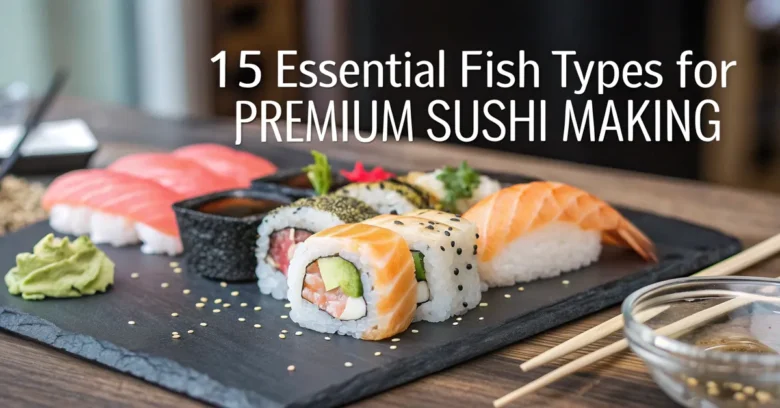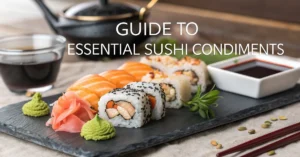Sushi. The mere mention of the word conjures images of vibrant colors, intricate arrangements, and an umami-rich experience that dances across the palate. But beyond the artful presentation lies a crucial element: the fish. Not just any fish will do; crafting truly premium sushi demands a careful selection of the finest, freshest catches. Are you ready to elevate your sushi game? Let’s dive deep into the world of sushi fish.
This article will explore 15 essential fish types for premium sushi making, providing insights into their flavor profiles, textures, and how to best prepare them. This guide equips you with the knowledge needed to curate exceptional sushi experiences, whether you’re a seasoned chef or a passionate home cook. We will reveal the secrets behind selecting the perfect cuts, respecting the delicate balance of flavors, and celebrating the ocean’s bounty in every bite.
Understanding the Essentials of Sushi Fish
Before we delve into the specifics, let’s establish some foundational principles.
Freshness is Paramount
This cannot be overstated. The quality of sushi hinges on the freshness of the fish. Look for vibrant color, firm texture, and a clean, sea-like aroma. Avoid anything that smells overly fishy or has a dull, lifeless appearance. A reputable fishmonger specializing in sushi-grade fish is your best ally. They can guide you on sourcing and ensure the fish has been handled and stored correctly to minimize bacterial growth and maintain optimal flavor.
“Sushi-Grade”: What Does It Really Mean?
The term “sushi-grade” isn’t legally regulated, so it’s vital to understand its implications. It generally signifies that the fish has been handled in a way that reduces the risk of parasites and bacterial contamination. This typically involves immediate bleeding and gutting after the catch, followed by rapid chilling or freezing to specific temperatures.
The Art of Cutting and Preparation
Proper cutting techniques are crucial for both presentation and flavor. Different cuts, like saku (block) and hira-zukuri (sliced), showcase the fish’s texture and grain in unique ways. Experienced sushi chefs often age certain fish types to enhance their umami and tenderness.
15 Essential Fish Types for Premium Sushi Making
Here are 15 fish varieties that belong in any serious sushi enthusiast’s repertoire, categorized for your convenience:
Tuna (Maguro) Varieties
Tuna is arguably the king of sushi fish, offering a range of flavors and textures depending on the species and cut.
1. Bluefin Tuna (Hon Maguro)
The most prized tuna, known for its rich, buttery flavor and melt-in-your-mouth texture. Bluefin is often graded based on its fat content, with otoro (the fattiest belly cut) being the most sought-after.
Flavor Profile: Intensely rich, umami, buttery.
Texture: Silky, smooth, fatty.
Best Uses: Nigiri, sashimi, high-end sushi rolls.
Selection Tips: Look for deep red color (for akami) and marbling (for otoro and chutoro). The flesh should be firm and almost translucent.
2. Yellowfin Tuna (Kihada Maguro)
A more affordable tuna option, Yellowfin has a milder flavor and leaner texture than Bluefin.
Flavor Profile: Mild, slightly sweet.
Texture: Firm, lean.
Best Uses: Nigiri, sashimi, sushi rolls (especially when seared).
Selection Tips: Look for vibrant pink to red color and a firm, almost translucent flesh.
3. Bigeye Tuna (Mebachi Maguro)
Bigeye tuna offers a balance between the richness of Bluefin and the leanness of Yellowfin.
Flavor Profile: Richer than Yellowfin, but less intense than Bluefin.
Texture: Slightly firmer than Bluefin, but still tender.
Best Uses: Nigiri, sashimi, sushi rolls.
Selection Tips: Look for deep red color and a slightly oily sheen.
White Fish (Shiromi) Delights
“White fish” encompasses a variety of species with delicate flavors and firm textures, providing a counterpoint to the richness of tuna.
4. Japanese Sea Bream (Madai)
Highly prized for its clean, subtly sweet flavor and firm, slightly chewy texture.
Flavor Profile: Clean, subtly sweet.
Texture: Firm, slightly chewy.
Best Uses: Nigiri, sashimi, often lightly cured or aged to enhance flavor.
Selection Tips: Look for vibrant pinkish-white color and a translucent appearance.
5. Flounder (Hirame)
A delicate, mild-flavored fish with a firm, almost crisp texture.
Flavor Profile: Mild, clean, slightly sweet.
Texture: Firm, crisp.
Best Uses: Nigiri, sashimi, often served with a touch of citrus.
Selection Tips: Look for translucent white flesh with a slight sheen.
6. Snapper (Tai)
Similar to sea bream, snapper offers a clean, subtly sweet flavor and firm texture.
Flavor Profile: Clean, subtly sweet, slightly more assertive than sea bream.
Texture: Firm, slightly chewy.
Best Uses: Nigiri, sashimi, grilled or seared preparations.
Selection Tips: Look for bright red skin (if skin-on) and firm, translucent white flesh.
Fatty and Flavorful Fish (Hikari-mono)
Hikari-mono refers to silver-skinned fish known for their oily texture and strong flavors. These require careful handling and preparation to balance their richness.
7. Mackerel (Saba)
Mackerel boasts a robust, distinctive flavor and oily texture. It’s often cured in salt and vinegar to tame its strong taste and enhance its umami.
Flavor Profile: Strong, oily, savory.
Texture: Oily, rich.
Best Uses: Nigiri, pressed sushi (oshizushi), often marinated or cured.
Selection Tips: Look for bright, silvery skin and firm flesh. A slight metallic sheen is normal.
8. Sardine (Iwashi)
Smaller and more delicate than mackerel, sardine offers a similar, though less intense, flavor profile.
Flavor Profile: Oily, savory, slightly fishy.
Texture: Soft, oily.
Best Uses: Nigiri, often served with ginger and scallions to balance the richness.
Selection Tips: Look for bright, silvery skin and plump, firm bodies.
9. Gizzard Shad (Kohada)
A small, silver-skinned fish with a strong, assertive flavor. It requires careful curing and preparation to balance its intensity.
Flavor Profile: Strong, oily, slightly sour.
Texture: Firm, oily.
Best Uses: Nigiri, a classic Edomae sushi ingredient, always cured or marinated.
Selection Tips: Look for bright, silvery skin and firm flesh. This is a less common fish, so finding a reputable supplier is crucial.
Salmon and Trout Sensations
While not traditional Edomae sushi ingredients, salmon and trout have gained immense popularity worldwide.
10. Salmon (Sake)
Beloved for its rich, buttery flavor and soft texture, salmon is a sushi staple.
Flavor Profile: Rich, buttery, slightly sweet.
Texture: Soft, fatty.
Best Uses: Nigiri, sashimi, sushi rolls.
Selection Tips: Look for vibrant orange color and distinct marbling. Farmed salmon is generally more consistent in quality and availability.
11. Trout (Masu)
Similar to salmon, trout offers a slightly leaner texture and a more delicate flavor.
Flavor Profile: Mild, slightly sweet, less oily than salmon.
Texture: Firmer than salmon, less fatty.
Best Uses: Nigiri, sashimi, sushi rolls.
Selection Tips: Look for bright pinkish-orange color and firm flesh.
Other Notable Mentions
These fish types offer unique flavors and textures that can elevate your sushi creations.
12. Eel (Unagi/Anago)
Eel is always cooked, usually grilled and glazed with a sweet and savory sauce. Unagi (freshwater eel) is richer and more flavorful, while anago (saltwater eel) is more delicate.
Flavor Profile: Sweet, savory, smoky.
Texture: Tender, flaky.
Best Uses: Nigiri, sushi rolls, often served warm.
Selection Tips: Look for plump, glossy fillets with a rich glaze.
13. Scallop (Hotate)
Scallops offer a sweet, delicate flavor and a tender, slightly chewy texture.
Flavor Profile: Sweet, delicate, slightly briny.
Texture: Tender, slightly chewy.
Best Uses: Nigiri, sashimi.
Selection Tips: Look for plump, firm scallops with a translucent appearance and a fresh, sea-like aroma.
14. Shrimp (Ebi)
Shrimp is another cooked sushi ingredient, offering a sweet, slightly briny flavor and a firm, snappy texture.
Flavor Profile: Sweet, slightly briny.
Texture: Firm, snappy.
Best Uses: Nigiri, sushi rolls.
Selection Tips: Look for firm, plump shrimp with a bright color.
15. Amberjack (Kanpachi)
Amberjack boasts a clean, refreshing flavor and a firm, slightly chewy texture.
Flavor Profile: Clean, refreshing, slightly sweet.
Texture: Firm, slightly chewy.
Best Uses: Nigiri, sashimi.
Selection Tips: Look for translucent white flesh with a slight pinkish hue.
Sourcing and Preparation Tips
Finding a Reputable Fishmonger
Building a relationship with a trusted fishmonger is paramount. They can provide guidance on sourcing, seasonality, and handling techniques. Look for a fishmonger who specializes in sushi-grade fish and is knowledgeable about the origins and handling of their products.
Understanding Seasonality
Like fruits and vegetables, fish have seasons when they are at their peak flavor and texture. Understanding seasonality allows you to select the best fish at the right time of year. Your fishmonger can provide insights on seasonal availability.
Proper Storage Techniques
Once you’ve sourced your fish, proper storage is crucial to maintain its freshness and quality. Keep fish refrigerated at temperatures between 32°F and 38°F (0°C and 3°C). Use it as soon as possible, ideally within 24 hours of purchase.
Mastering Basic Cutting Techniques
Learning basic cutting techniques, such as slicing fish for nigiri and sashimi, will significantly improve your sushi presentation and flavor. Invest in a sharp sushi knife (Yanagiba) and practice your technique.
Beyond the Basics: Elevating Your Sushi Game
Aging Fish (Jukusei)
Aging fish, a technique known as jukusei, can enhance its umami and tenderness. This involves carefully storing the fish under controlled conditions to allow enzymes to break down proteins and fats. This technique requires expertise and precision to avoid spoilage.
Curing and Marinating
Curing fish in salt, vinegar, or other seasonings can transform its flavor and texture. This technique is particularly useful for oily fish like mackerel, helping to balance their richness.
Exploring Regional Variations
Sushi styles vary across Japan, with each region showcasing unique ingredients and techniques. Explore regional variations to expand your sushi knowledge and creativity.
Conclusion: The Art of Sushi is a Journey
Crafting premium sushi is an ongoing journey of learning, experimentation, and appreciation for the ocean’s bounty. With the knowledge of these 15 essential fish types, you’re well-equipped to create extraordinary sushi experiences. Now, why not head to your local fishmonger to begin your adventure? The art of sushi awaits your exploration!



